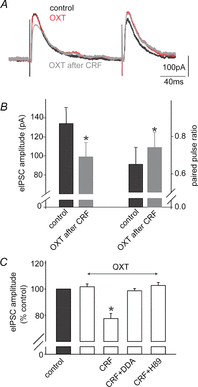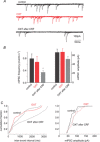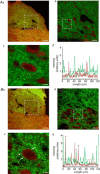Plasticity in the brainstem vagal circuits controlling gastric motor function triggered by corticotropin releasing factor
- PMID: 25128570
- PMCID: PMC4287746
- DOI: 10.1113/jphysiol.2014.278192
Plasticity in the brainstem vagal circuits controlling gastric motor function triggered by corticotropin releasing factor
Abstract
Stress impairs gastric emptying, reduces stomach compliance and induces early satiety via vagal actions. We have shown recently that the ability of the anti-stress neuropeptide oxytocin (OXT) to modulate vagal brainstem circuits undergoes short-term plasticity via alterations in cAMP levels subsequent to vagal afferent fibre-dependent activation of metabotropic glutamate receptors. The aim of the present study was to test the hypothesis that the OXT-induced gastric response undergoes plastic changes in the presence of the prototypical stress hormone, corticotropin releasing factor (CRF). Whole cell patch clamp recordings showed that CRF increased inhibitory GABAergic synaptic transmission to identified corpus-projecting dorsal motor nucleus of the vagus (DMV) neurones. In naive brainstem slices, OXT perfusion had no effect on inhibitory synaptic transmission; following exposure to CRF (and recovery from its actions), however, re-application of OXT inhibited GABAergic transmission in the majority of neurones tested. This uncovering of the OXT response was antagonized by pretreatment with protein kinase A or adenylate cyclase inhibitors, H89 and di-deoxyadenosine, respectively, indicating a cAMP-mediated mechanism. In naive animals, OXT microinjection in the dorsal vagal complex induced a NO-mediated corpus relaxation. Following CRF pretreatment, however, microinjection of OXT attenuated or, at times reversed, the gastric relaxation which was insensitive to l-NAME but was antagonized by pretreatment with a VIP antagonist. Immunohistochemical analyses of vagal motoneurones showed an increased number of oxytocin receptors present on GABAergic terminals of CRF-treated or stressed vs. naive rats. These results indicate that CRF alters vagal inhibitory circuits that uncover the ability of OXT to modulate GABAergic currents and modifies the gastric corpus motility response to OXT.
© 2014 The Authors. The Journal of Physiology © 2014 The Physiological Society.
Figures





Similar articles
-
Vagal afferent fibres determine the oxytocin-induced modulation of gastric tone.J Physiol. 2013 Jun 15;591(12):3081-100. doi: 10.1113/jphysiol.2013.253732. Epub 2013 Apr 15. J Physiol. 2013. PMID: 23587885 Free PMC article.
-
Stress-induced neuroplasticity in the gastric response to brainstem oxytocin in male rats.Am J Physiol Gastrointest Liver Physiol. 2022 May 1;322(5):G513-G522. doi: 10.1152/ajpgi.00347.2021. Epub 2022 Feb 16. Am J Physiol Gastrointest Liver Physiol. 2022. PMID: 35170350 Free PMC article.
-
Perinatal high-fat diet exposure alters oxytocin and corticotropin releasing factor inputs onto vagal neurocircuits controlling gastric motility.J Physiol. 2023 Jul;601(14):2853-2875. doi: 10.1113/JP284726. Epub 2023 May 17. J Physiol. 2023. PMID: 37154244 Free PMC article.
-
Short-term receptor trafficking in the dorsal vagal complex: an overview.Auton Neurosci. 2006 Jun 30;126-127:2-8. doi: 10.1016/j.autneu.2006.01.019. Epub 2006 Mar 6. Auton Neurosci. 2006. PMID: 16580267 Free PMC article. Review.
-
Role of selected peptides in the vagal regulation of gastric motor and endocrine pancreatic function.J Physiol Pharmacol. 1996 Sep;47(3):399-409. J Physiol Pharmacol. 1996. PMID: 8877896 Review.
Cited by
-
Central control of gastrointestinal motility.Curr Opin Endocrinol Diabetes Obes. 2019 Feb;26(1):11-16. doi: 10.1097/MED.0000000000000449. Curr Opin Endocrinol Diabetes Obes. 2019. PMID: 30418187 Free PMC article. Review.
-
Perinatal high fat diet increases inhibition of dorsal motor nucleus of the vagus neurons regulating gastric functions.Neurogastroenterol Motil. 2018 Jan;30(1):10.1111/nmo.13150. doi: 10.1111/nmo.13150. Epub 2017 Aug 1. Neurogastroenterol Motil. 2018. PMID: 28762595 Free PMC article.
-
Brain and Gut CRF Signaling: Biological Actions and Role in the Gastrointestinal Tract.Curr Mol Pharmacol. 2018;11(1):51-71. doi: 10.2174/1874467210666170224095741. Curr Mol Pharmacol. 2018. PMID: 28240194 Free PMC article. Review.
-
Apelin-13 inhibits gastric motility through vagal cholinergic pathway in rats.Am J Physiol Gastrointest Liver Physiol. 2018 Feb 1;314(2):G201-G210. doi: 10.1152/ajpgi.00223.2017. Epub 2017 Oct 12. Am J Physiol Gastrointest Liver Physiol. 2018. PMID: 29025730 Free PMC article.
-
Vagally mediated gastric effects of brain stem α2-adrenoceptor activation in stressed rats.Am J Physiol Gastrointest Liver Physiol. 2018 Apr 1;314(4):G504-G516. doi: 10.1152/ajpgi.00382.2017. Epub 2018 Jan 11. Am J Physiol Gastrointest Liver Physiol. 2018. PMID: 29351390 Free PMC article.
References
-
- Babygirija R, Bulbul M, Cerjak D, Ludwig K, Takahashi T. Sustained acceleration of colonic transit following chronic homotypic stress in oxytocin knockout mice. Neurosci Lett. 2011;495:77–81. - PubMed
-
- Babygirija R, Bulbul M, Yoshimoto S, Ludwig K, Takahashi T. Central and peripheral release of oxytocin following chronic homotypic stress in rats. Auton Neurosci. 2012;167:56–60. - PubMed
-
- Babygirija R, Zheng J, Bulbul M, Cerjak D, Ludwig K, Takahashi T. Sustained delayed gastric emptying during repeated restraint stress in oxytocin knockout mice. J Neuroendocrinol. 2010a;22:1181–1186. - PubMed
Publication types
MeSH terms
Substances
Grants and funding
LinkOut - more resources
Full Text Sources
Other Literature Sources

